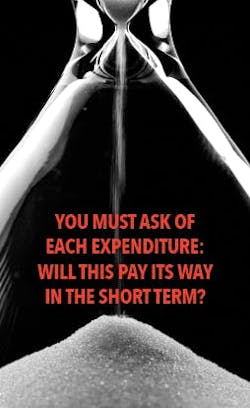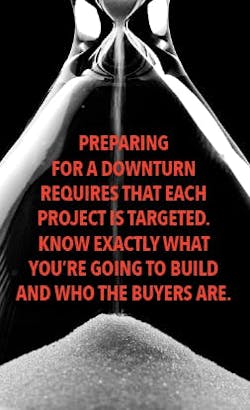The Next Housing Downturn—Is It Too Late to Get Your Business Ready?
I recently read a provocative statement by a home building pundit. In so many words, this authority declared that unless a builder began two or three years ago, it is too late to prepare for the next downturn. If a builder is sitting on a big land purchase needing three, four, or more years to secure entitlement and start production, our expert has a point—there’s nothing like breaking ground just when the market slows or sitting on a mountain of unproductive fixed assets in the middle of a downturn. The impact is no different than a shuttered manufacturing plant—all that capital sitting around, doing nothing but generating carrying costs.
Excess land/lot inventory was the most obvious factor that took down so many builders in the last great housing crash, which reached its low point a decade ago. Back in my national builder days, the debate over buying large tracts of land for development versus phased “takedowns” at a contracted price raged on endlessly. Yes, you pay a considerable fee for lot options, which increase your finished lot cost and take away a chunk of your profit. The takedown strategy, however, protects a builder, reduces risk, and allows a much nimbler response in a down market.
On the other hand, in good times, the builder that buys and holds land for production will nearly always make more money. Then again, in bad times, a large land/lot bank can eat you alive. And so it goes …
Where are we now in the current market cycle? When does the next downturn arrive? Is it really too late to prepare? Around the country today we see flat to slow growth in most markets with good cash flow, yet reduced profit margins.
The increased cost of raw land, entitlement, development, labor, material, and overhead, combined with the nationwide trade shortage, drive the biggest concern of all: housing affordability. Simply put, according to most market analysts, we are overpriced at every level—not an easy problem to solve. Can we reduce sales prices when margins are already compromised?
Recession Predictions and What You Should Do
From most accounts, there are no imminent signs of a major downturn in 2019. In fact, recent surveys show builder confidence is up. The structural demand from population growth and replacing dilapidated housing is typically estimated at around 1.6 million units annually. That’s half a million more units than we are currently building, so the latent demand bodes well for housing—if we can solve the affordability conundrum. Interest rates are low, people are working, wages are rising, but there are looming threats from tariff wars with China, Mexico, the European Union, and who knows where else by the time you read this. Now add in the rapidly growing, record federal spending deficit. At some point, we’ll have to face up to this reality, and it won’t be pretty.
After surveying 100 economists and real estate experts, online real estate pioneer Zillow published a report in May 2018 concluding that the target date for the next downturn is first quarter 2020. One year later, in May 2019, Zillow ran the survey again, and the consensus held: an expected slowdown in Q1 2020. That’s just six to nine months from now. Given all of the positive factors out there, can this be?
I know one strong, quite large builder that decided to cut its exposure last year and intentionally pulled back its number of 2019 forecast units by a third compared with 2018. Are they kicking themselves now? They absolutely could have sold more this year and made more profit, but what is the cost/benefit of preparation? Will their caution prove an investment or an expense? Only time will tell, but now it’s time to get up, splash cold water on your face, and stare down that previously confident image in the mirror. Are you ready for the downturn, whether it arrives in early 2020 or holds off for another few months or even years? Is it possible to reap the benefits of the current market, yet still prepare for the slowdown?
No matter their land/lot situation, who would tell a builder there is nothing they can do? Any builder with the backing to make land purchases of a size that can pose a danger already has significant production in progress and thus has almost unlimited opportunities to prepare for the downturn—without compromising current sales. In fact, they can improve both current sales and margins while simultaneously getting ready.
Flying in the face of “nothing can be done,” my TrueNorth colleagues and I have seen many builders of all sizes and types across North America make dramatic, systemic changes to their businesses within a year or even faster.
Breakeven or Bust for Home Builders
As I worked on a list of key strategies and tactics to help home builders prepare for the downturn most believe will come, I thought back over some of the discussions I’ve had with builders and other consultants during recent conferences, builder club meetings, and client visits. The venerable concept of “breakeven point” keeps raising its head.
Is there any better way to organize your thoughts and actions to prepare for a weakening of the market than thinking in terms of how many units you have to sell to break even and how you can lower the number to guard against a slowdown or dive? It’s certainly compelling. At what point in a given year are all of the fixed costs covered? Consider a simple, classic definition of breakeven:
Breakeven point based on units: Total fixed costs divided by revenue per unit minus variable cost per unit.
Fixed costs don’t change, no matter how many units are sold. The variable costs per unit rise or fall with volume. Do the math and get your number. OK, how’s that working for you? Now, cut the number of units by a quarter or a third. Do the math again. Can you still breathe? If not, it’s time to get to work.
Fixed and variable are not nearly as clean as they sound. Thus a breakeven analysis, so straightforward in an accounting text, gets messy when builders classify fixed and variable in many divergent ways, and costs are often a mix of the two.
The classic example is the cost of a salesforce. Recently, in a long discussion on sales compensation with four builders, three said they pay their salespeople salaries ranging from an intro of $35K to as much as $65K for an experienced representative, plus commission on top. They believe this is necessary to attract and keep the best people. The fourth builder pays 100% commission and is adamant it’s the only way to go.
Obviously, the builders paying salaries plus commission have a greater percentage of fixed cost, raising their breakeven higher. The fourth builder has 100% variable sales compensation. He carries less risk if sales slow, but the harsh reality is that salaried folks can be laid off quickly if required, so the fourth builder’s advantage is probably no more than a month or two. Yet builder No. 4 will indeed show a lower breakeven point.
I had a client once tell me all of his costs were variable—100%! This presumes total elasticity in all of your overhead including rent, salaries, insurance, the carry costs of your model homes, and even the copy machine. He asserted that each cost goes up and down exactly with volume.
I suppose we can conjure a scenario where this could be, but let’s not waste time on that because it’s not a reality for most builders. The key is absorption of the fixed costs—a concept pounded into my colleagues and me decades ago while working for the late Bill Pulte. Since most builders aren’t shrinking at this juncture, this means limiting any additions to fixed cost wherever possible. Can we build one more house without hiring anyone, buying equipment, or adding support staff? How about 10? Twenty? If so, absorption goes up and breakeven, relative to total volume, goes down.
Right now, I’d be very careful about making an investment, whether it's moving into a new building at a higher monthly rent or making any investment in people, land, or capital equipment that can’t stand up to tough examination. Of course, there are exceptions. One client is not only bringing on new people but is hiring them far earlier than most builders, to facilitate more thorough training. He’s building in a unique niche, however, and makes a strong case for being more liberal with these costs.
Although historically I’m a big advocate of the long-term view, in consideration of the 2020 forecast, you must ask of each expenditure: Will this pay its way in the short term?
One problem with breakeven is accounting tends to treat variable costs as a set amount per unit, which rises or falls in exact proportion to volume. Sounds rather strange, but viewed this way, variable cost becomes, in a sense, a fixed cost per unit. We all know from experience this isn’t true. Labor and materials prices can vary significantly across months or even years of building a community. Bill Pulte used to preach, “Know and fix your costs! Know and fix your costs!” Those are still great watchwords today, but frankly, I think it’s tougher now than it was 20 or 30 years ago. Even in these times of still-rising labor, material, and overhead costs, we can’t fall victim to the assumption that significant improvement isn’t readily available.
Continual improvement of product and process through the application of Lean thinking and techniques—the relentless pursuit and removal of waste in product and process, which is bigger than but includes value engineering—is the best way to make this happen. Builders in every market are achieving such results, lowering breakeven, and feeling a lot better about what may come in 2020—or not.
Business Strategies for the Downturn—and for Today
Preparing for a downturn requires that each project you undertake be completely targeted, knowing exactly what you’re going to build and who the buyers are. Prove it. This isn’t a time for wishful thinking—or building.
Your finances, of course, must be in order. Reduce debt and refinance anything possible at a lower rate today, while money is cheap. Operationally, over the past years in multiple columns, I have described many avenues to reduce both fixed and variable cost per unit. Here are three I’ve found particularly powerful in the breakeven game.
1. Variance reduction
This qualifies as an industrywide epidemic in most locations. A lot of it began during the previous downturn, when, in order to sell a home, most builders were willing to change almost anything a client wanted. This was much easier at lower volume levels, but at today’s building pace, the resultant variance purchase orders (VPOs—aka FPOs, EPOs) are among the biggest profit killers. Awhile back I set out to write a column about the impact of variance, which was so big an issue that my column morphed into a series of four. The most important things to remember are:
• No one, including your suppliers and trades, makes money on variance.
• No builder in America measures variance fully or correctly. (They leave out overhead to the builder, suppliers, and trades—and that’s where the money is.)
• Excess plans, elevations, and options are significant contributors to variance.
2. Schedule and cycle-time reduction
Most builders aren’t nearly as tight with schedules and cycle times as they were prior to the last big downturn. Sure, the trade shortage makes it hard, yet we know plenty of builders that have overcome it. A few key points:
• Reducing work-in-process inventory of homes in production is a great goal for good times and is absolutely critical in a slowdown.
• Reducing cycle time significantly reduces the load on field superintendents. You can do more with less.
• A tight, predictable schedule is among the key factors for attracting top trades.
3. Simplification (plans, options, design center cleanup)
Every option requires a thorough total cost analysis. Many are less profitable than you think.
• Uncontrolled complexity is the enemy of quality, cycle time, and low variance.
• Many design centers have grown beyond what’s needed to meet customer needs and aren’t as profitable as believed.
The one thing we absolutely cannot count on to lower breakeven in this market is increases in retail sales price. In fact, given that we are overpriced in each segment, exactly the opposite must happen. Daunting to think about price reductions, isn’t it? Yet the great majority of builders won’t tackle this issue seriously until the downturn is fully upon us. Will you? To reduce sales price and maintain an acceptable margin, you need to start today. Challenge every fixed cost and search relentlessly for every possible waste in the variable cost for each unit. Lower your breakeven point this year, so no matter what comes in the years ahead, it won’t break you.
For a copy of this column as a part of the latest edition of Scott’s series, “Bridging the Margin Gap,” send a request via email to [email protected] and include “Margin Gap” in the subject line, or call us at 248.446.1275.
Access a PDF of this article in Professional Builder's July 2019 digital edition



